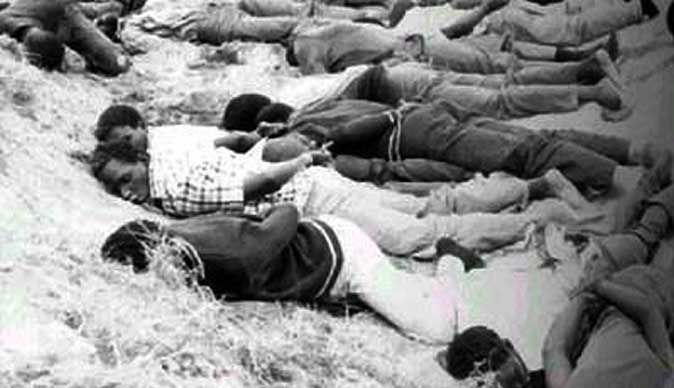
EXCLUSIVE: Gukurahundi skeletons tumble out of the closet
26 July 2018AS Zimbabwe inches towards critical general elections on Monday, skeletons of Gukurahundi massacres – which remain an emotive political and electoral issue in the country – are tumbling out of the closet.
A top-secret dossier providing never-seen-before details compiled in the 1980s by international relief agencies on the ground, and sent to Zimbabwe’s deposed ruler Robert Mugabe, shows the former strongman got but ignored reports of a rampage of massacres of civilians – including women and children – in Matabeleland and Midlands regions in the 1980s.
The dossier, which contains reports from doctors, nurses, headmasters, teachers and civilians, together with pictures of badly injured and dying people, paints a horrific picture of how soldiers killed civilians under the pretext of combating “dissidents” during Mugabe’s scorched earth policy campaign.
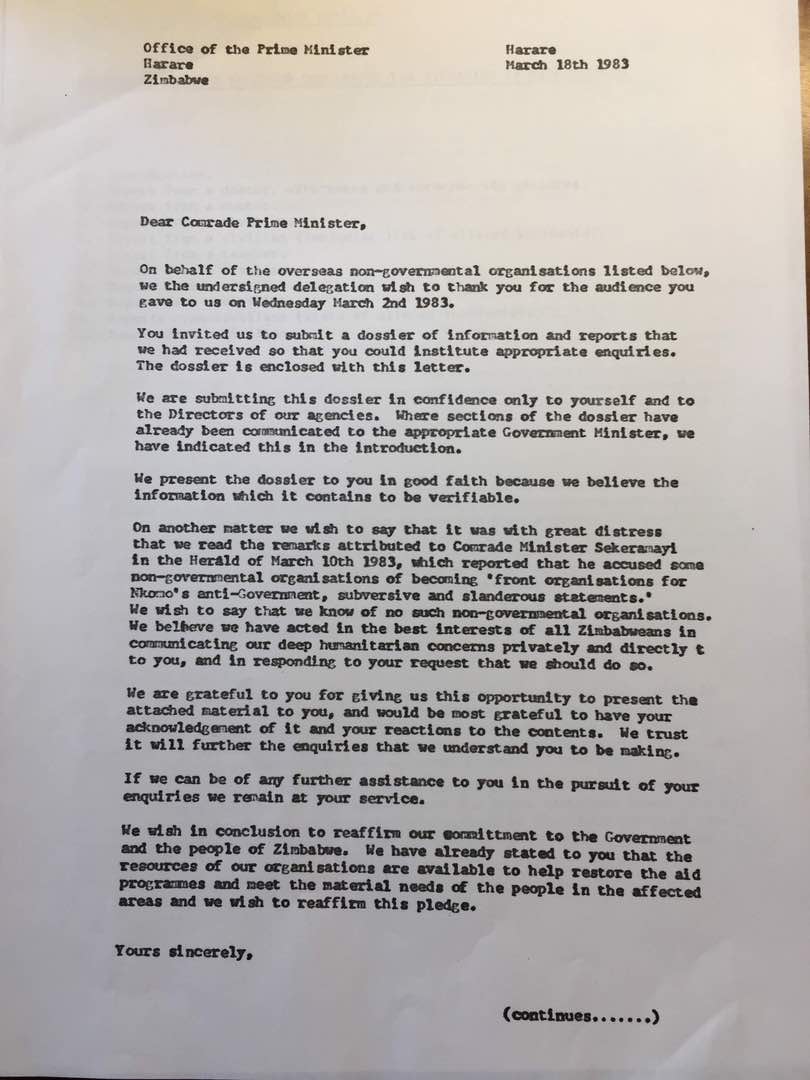
According to the never-seen-before report on the Gukurahundi Massacre, Mugabe was informed about the senseless killings in the Matebeleland but ignored the warnings
The new information adds to declassified reports released in recent years implicating Mugabe in orchestrating the atrocities for political gain in areas then controlled by his bitter rival, the late opposition PF Zapu Joshua Nkomo.
The document, compiled by non-governmental organisations (NGOs) led by British-based Oxfam International and recently obtained and corroborated by Botswana’s INK Centre for Investigative Journalism and the Zimbabwe Independent, provides new details, including a list of names of those killed by the North Korean-trained crack military unit, the Fifth Brigade.
A long list of people killed, including villagers, teachers and councillors, under state emergency conditions in areas such Nkayi, Lupane and Tsholotsho in Matabeleland North province – before the massacres rapidly spread to Matabeleland South and Midlands provinces – is provided in a confidential report sent to Mugabe after he had met NGO workers on March 2, 1983.
Bhalagwe, where civilians were killed and dumped in derelict mining shafts, in Matabeleland South later became Zimbabwe’s own version of Nazi German concentration camp Buchenwald.
Former Higher Education minister Jonathan Moyo’s father’s name – Job Melusi Mlevu, a Zapu councillor then – is also on the list of those killed. He was killed on January 22, 1983 in Tsholotsho, according to the report.
The report shows most of the people were killed for political and ethnic reasons through brutal attacks, bayonetting and gunshots, including pregnant women, children and the elderly.
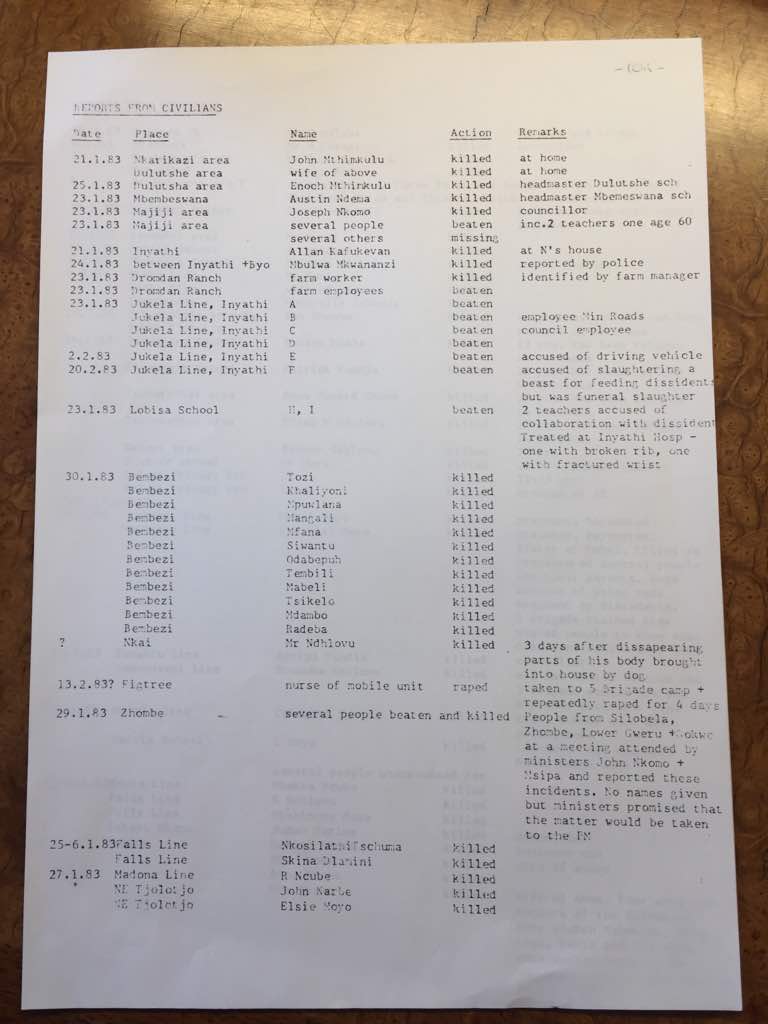
A report detailing the extent of the massacre was presented to Mugabe during the first months of the massacre which later claimed the lives of more than 20 000 Matebele people.
Mugabe had at the meeting with NGOs asked the humanitarian organisations to submit a report on the violence and killings for him to investigate the issue. The NGOs enclosed the dossier in a letter to him written on March 18, 1983 – exactly 16 days after the meeting.
The shocking revelations forced Mugabe to appoint the Chihambakwe Commission to investigated the Gukurahundi massacres in which an estimated
20 000 people were eventually killed. The resultant report was not made public.
Mugabe has over the years wavered between hesitant admission and weak denial of responsibility and the magnitude of the killings, amid growing evidence and proof of massacres.
In March this year, Mugabe told the Independent in an exclusive interview at his mansion in Harare that Ndebeles and Zapu were to blame as they resisted his rule from the start through “dissident activities”, but also partly took responsibility for ordering the murderous operation.

Mugabe and his cabinet including the current President Emmerson Mnangagwa are blamed for orchestrating and failing to stop the massacre (AP Photo/Tsvangirayi Mukwazhi, File)
However, one of the key central characters in the deadly civil strife drama, former Zipra intelligence supremo Dumiso Dabengwa during the liberation struggle fiercely hit back at Mugabe, charging he orchestrated the bloodbath.
Mugabe also specifically blamed the killings on President Emmerson Mnangagwa – who toppled him through a military coup last November – and the security forces.
Mnangagwa has, however, been at pains to deny responsibility, saying he was only in charge of intelligence operations during the massacres – effectively blaming Mugabe who was the commander-in-chief.
Mnangagwa is still haunted by the ghosts of the killings. Under pressure, he has appointed a National Peace and Reconciliation Commission panel to investigate the atrocities, regarded in some circles genocide. However, critics say the probe will be a whitewash and would gloss over the truth as the president is implicated.
The NGOs report details how the Fifth Brigade in three months rampaged through the Matabeleland and Midlands killing fields, leaving a bloody trail its wake. It said its information was verifiable.
“On behalf of the overseas non-governmental organisations listed below, we the undersigned delegation wish to thank you for the audience you gave to us on Wednesday March 2nd 1983,” the NGOs’ letter to Mugabe, dated March 18, 1983, says.
“You invited us to submit a dossier of information and reports that we had received so that you could institute appropriate enquiries. The dossier is enclosed with this letter.”
READ MORE: The damning Gukurahundi dossier that Mugabe frowned upon
The dossier says NGOs had received allegations and found evidence of “the perpetration of widespread acts of murder and brutality by members of the security forces against unarmed civilians” and “the cutting off by the army of food supplies to certain regions already badly affected by drought and the disruption of medical care, thereby causing conditions of potential death through starvation or death through delayed and inadequate medical care.”
Soldiers indiscriminately attacked civilians they accused of feeding or harbouring the dissidents as they unleashed a wave of terror never witnessed in the region. So brutal was the operation that in a short space of time, hundreds of people had been killed and thousand others injured and displaced. Many people had to flee from their homes, some going as far as Botswana and South Africa.
Public executions and arbitrary killings were commonplace; while corpses were eaten away by dogs and maggots feasted on badly injured people who stayed in bushes having fled from the marauding troops. A disturbing incident of a women being executed with bayonets was also reported.
The report, for instance, says six teachers and a civilian were killed at a Tsholotsho primary school and their bodies “were thrown into a pit latrine”. Their names are given.
“Nine shallow graves were discovered just north of a small kopje located west of the road leading to Broadwell farm on the Mafeiking Road about 30 kilometres south of Bulawayo. The graves were shallow enough to see that one of the victims had been shot in the back of the head. Another victim’s shoe clad feet were sticking out of the earth. Both were male,” the report says.
Another mass grave containing 10 corpses was discovered on the other side of the dirt road leading to Broadwell farm.
“Gunshots heard by local people 10 days earlier suggested the victims could have been killed sometime during the fourth week of February in 1983,” the report adds.
Five bodies found near a school in Nyamandlohvu district were attacked by dogs after the fear-stricken police failed to collect them.
A farmer near the area was horrified to discover that four of his workers were shot while milking cows. Another five had their workers shot on a farm close to the school between February 4 and 6, 1983.
“At Nyamandlovu clinic, several bayonet and gunshot wounds were being seen that day. One lady had holes through her hands and feet through “crucifixion with a bayonet. A mentally disturbed woman who is known locally as quite harmless had severe burns after soldiers had poured boiling water over her. There were many rape, assault and general beatings victims,” it says.
Tsholotsho hospital received up to 10 people daily, with some eventually dying from gunshot wounds. Some died before reaching the hospital.
In Nyamandlovu “soldiers go door-to door at night and force women to have sex, with a different soldier every night,” it says.
In the same area, 11 people were killed between February 11 and13, 1983 and were buried in a mass grave. Their names are included in the report.
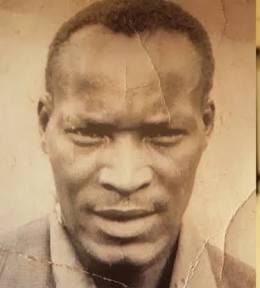
This opposition PF ZAPU councillor Job Melusi Mlevu, father to former Higher Education Minister Jonathan Moyo, who was killed in January 22, 1983, according to the report
“As all these things happened, many people ran away from their homes, teachers and school children deserted their schools and ran away for shelter to their nearest town, i.e. Bulawayo, Gweru or Kwekwe. Some homes were deserted too and when Five Brigade found these homes without people, they burnt them down.”
“At Tobotobo in Insuza, a helicopter burnt several homes because the inhabitants had fled into a bush.”
Among the areas that were terrorised were Lupane, Inyathi, Bembesi, Tsholotsho, Inkayi, Silobela and Nkosikazi.
After February 8, 1983 a lot of atrocities were committed in Western Tsholotsho.
“Two eye witnesses saw two people shot because they had firearms for which they had documents. They also saw 21 people being locked into a hut and the hut set on fire. Another witness saw three of her uncles taken to a kraal where they were shot in cold blood by the soldiers.”
On February 5 1983, 21 people were killed in St Pauls’ area in Lupane. “Other people in the Tjolotjo (now Tsholotsho) have been reported as killed, including 15 employees of the TILCOR estate. A butcher was accused of being a Zapu supporter and was killed.
A doctor who worked on the general surgical and orthopaedic wards for six months in Matabeleland described horrifying results of injury suffered by civilians, soldiers and dissidents as a consequence of the crackdown.
He said before mid-January 1983, there was a steady intake of patients on the wards – three or so per week.
“The majority were civilians suffering from gunshot injuries. During this time the casualty department was treating similar cases whose injuries did not require admission to the wards,” he said.
“From about mid-January onwards there was a sudden increase in the numbers of people we were treating. The victims were civilians from rural areas north of Bulawayo. The surgical and orthopaedic wards were admitting 3 to 4 per day.
“The majority of them said they were lucky to have made the journey to Bulawayo and that hundreds of injured and dying people were trapped in rural areas and were either being treated at local clinics or not receiving any medical attention at all. Some of the patients had received their injuries a week or so prior to admission (some were adult females – I saw no injured children)
“Most patients were male. Commonest injuries were multi-fractures of legs caused by shrapnel, bullets or beating. There were also abdominal and chest gunshot injuries. Cases which were a result of beatings usually presented with multiple bruising especially on the buttocks, but also on the back of the thighs and on the upper arms and chest.”
Apart from the killings, soldiers also starved their victims by closing shops.
“When a curfew was declared in Matebeleland North in the following areas – Bubi, (Ntabazinduna, Fingo Location, Inyati and Nkosikazi), Tsholotsho, Lupane, Inkayi, Silobela and Zhombe all shops were closed, isolating people from food supplies,” the dossier says.
“All government food aid was stopped. This left many families without food supplies for an indefinite period. Most storage bans were empty. The little grain they have can only be stamped or boiled before they can eat it as all grinding mills are closed. Buses and other means of transport have been stopped to cripple movement of people and transportation of food.
“Many stray animals — cattle, sheep, goats and donkeys – are straying and destroying crops because most of the boys who often look after them have disappeared from their homes. This will cause a greater food shortage…”
However, “where they are bottle stores and beer gardens, the army has ordered that they be opened to serve the interests of the army. They are often very drunk, and when so drunk, they are most brutal to the civilians.”
The report accuses the Fifth Brigade of seeking revenge and settling tribal scores through the killings.
“Most members of the Five Brigade are Shona-speaking; some cannot speak English or English properly. They expect everybody in Matebeleland to speak Shona. Those who cannot are victimised.
“They accuse Ndebeles of being foreigners who came from South Africa and that they killed their forefathers, took their cattle and corn. They say they will destroy all the Matabeles because they have been deployed to kill them.”
On January 27, 1983, an acting headmaster of a school was beaten at a roadblock on the main road joining Ntabazinduna for no reason. Afterwards he was asked: ‘Where are our grandfather’s cattle?’. The acting headmaster also reported that he witnessed a boy herding cattle being shot.
But Shona-speaking people in the affected regions were also not spared.
“Some Shona-speaking families who came to settle at Cauna Jena were murdered because they were accused of spying for Zapu. A Shona army deserter who had visited a relative who was a priest was shot in public at Kana shops, hospital records showed,” the report says.
It adds: “Several girls and young women were reported to have been raped at Inyathi.”
At Tjolotjo growth point, a Catholic brother (European) who persistently asked a soldier why the soldiers was beating a woman (mission cook) was severely beaten by soldiers on February 5, (1983) after he was accused of being cheeky. He needed 17 stitches to his head at St. Luke’s hospital. His watch was taken away.”
The massacres have also been documented in declassified records in Britain, South Africa and other countries.
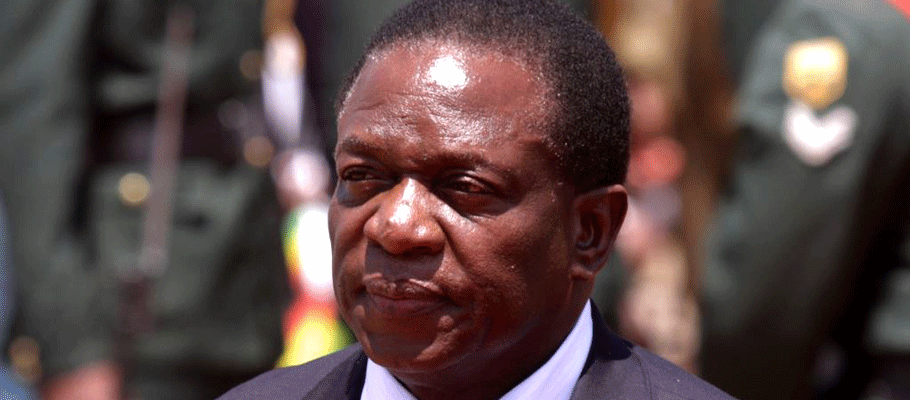
Mnangagwa together with other senior ZANU PF officials have been blamed for the senseless killings of people in the Matebele Province (Pic:Zimbabwe Independent)
A report titled Breaking the Silence, Building True Peace: A report into the disturbances in Matabeleland and the Midlands – 1980–1988 was produced by the Catholic Commission for Justice and Peace in Zimbabwe and the Legal Resources Foundation in 1999.
There have also been research papers and books written in recent years by respected scholars such as TimothyScarnecchia, Hazel Cameron and Stuart Doran on the issue.
Former Zimbabwean Central Intelligence Organisation officer, Kevin Woods, who acted as an apartheid double-agent and spy, in 2008 after his pardon on death sentence wrote a book, The Kevin Woods Story: In the Shadows of Mugabe’s Gallows blaming Mugabe, Mnangagwa, Agriculture minister Perence Shiri and deputy president Constantino Chiwenga, who were both army commanders at the time (Shiri was commander of the Fifth Brigade), former Defence minister Sydney Sekeramayi and the military for the massacres.
* This investigative report was produced by anonymous reporters in Zimbabwe and INK Centre for Investigative Journalism in collaboration with the Zimbabwe Independent.


Join the Conversation